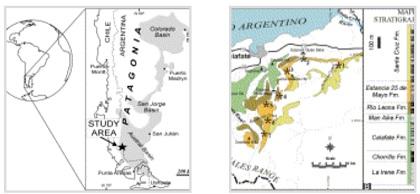José I. Cuitiño. Author, Roberto A. Scasso
2 013
Sedimentary Geology Volume 289, 1 May 2013, Pages 194-209
Two meter-scale pyroclastic levels are interbedded within the early Miocene succession of the Estancia 25 de Mayo (Patagoniense transgression) and Santa Cruz formations in the foreland Austral (or Magallanes) Basin, Argentina. The Lower Pyroclastic Level (LPL) is a tabular body interbedded within offshore marine deposits, laterally continuous for 30 km and varying in thickness from few centimeters to around 4 m. Grain-size grades from coarse to extremely fine ash with upward-fining along with a northeastern-fining trends. Structureless fine to very fine tuffs dominate and rare parallel laminations are the only tractive sedimentary structures. The Upper Pyroclastic Level (UPL) lies within low energy fluvial deposits and is laterally discontinuous, and it is composed by lenticular bodies reaching a maximum of 15 m thick and 100 m wide, with a concave-up base and a plane top. Grain-size range is similar to the LPL but it coarsens upward. The lower portion of the UPL shows parallel lamination, current ripple lamination and mud drapes with large pumice lapilli and plant debris, whereas the upper portion shows parallel lamination and trough cross-stratification. Both pyroclastic levels are composed mainly of pumice grains and glass shards with minor proportions of quartz and plagioclase crystals and lithic fragments. The LPL shows no mixing with epiclastic material whereas the UPL shows an upward increase in epiclastic material, and an upward increment in the scale of cross-bedding.
The large thickness in relation to the possible emission center and the content of plant debris of the LPL does not suggest a direct, submarine, ash-fallout origin. The LPL is interpreted as a deposit of hyperpycnal-flows generated at the coastal zone when tephra-laden rivers plunged into the ocean. Large amounts of well preserved plant debris support the hypothesis of a terrestrial source of the sediments. The UPL is entirely composed of tractive deposits, so an ash fallout origin is disregarded. This, together with the lenticular shape and the alluvial plain origin of the encasing sediments, suggests accumulation within fluvial channels. Cycles of upper-flow-regime parallel lamination, current-ripple lamination and mud drapes at the lower portion, suggest short-lived turbulent flows that initially filled semi-abandoned channels. They were followed by sheet floods and channel reactivation, expressed by large-scale cross-bedding. The low degree of particle mixing observed in both levels is explained by the inability of streams to erode the substrate as they are suddenly over-saturated with pyroclastic sediments during and after the eruption. The grain-size distribution of the LPL and geochemical data indicate a contemporaneous volcanic source located to the west/southwest in the Andean ranges, where the South Patagonian Batholith is presently located.
The large thickness in relation to the possible emission center and the content of plant debris of the LPL does not suggest a direct, submarine, ash-fallout origin. The LPL is interpreted as a deposit of hyperpycnal-flows generated at the coastal zone when tephra-laden rivers plunged into the ocean. Large amounts of well preserved plant debris support the hypothesis of a terrestrial source of the sediments. The UPL is entirely composed of tractive deposits, so an ash fallout origin is disregarded. This, together with the lenticular shape and the alluvial plain origin of the encasing sediments, suggests accumulation within fluvial channels. Cycles of upper-flow-regime parallel lamination, current-ripple lamination and mud drapes at the lower portion, suggest short-lived turbulent flows that initially filled semi-abandoned channels. They were followed by sheet floods and channel reactivation, expressed by large-scale cross-bedding. The low degree of particle mixing observed in both levels is explained by the inability of streams to erode the substrate as they are suddenly over-saturated with pyroclastic sediments during and after the eruption. The grain-size distribution of the LPL and geochemical data indicate a contemporaneous volcanic source located to the west/southwest in the Andean ranges, where the South Patagonian Batholith is presently located.

